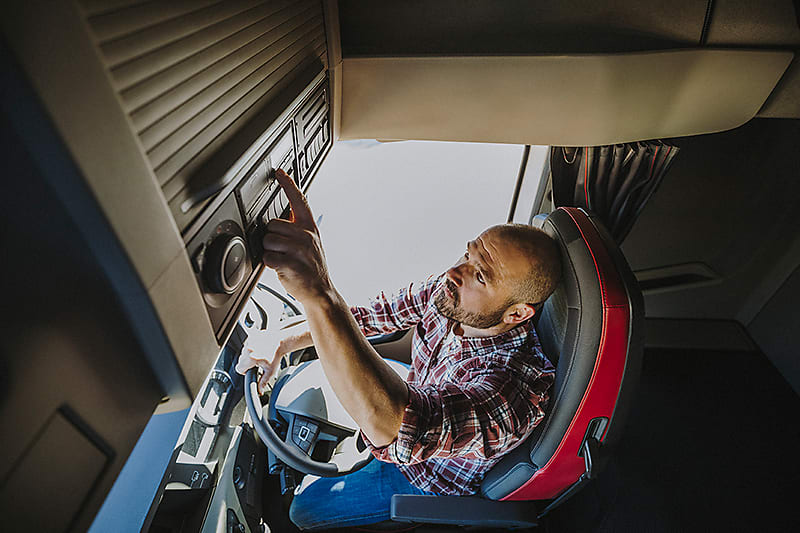
The introduction of the digital tachograph card means fleet managers can now monitor and store driver data, in a cost-effective, efficient manner. This article will provide you with the different card types, how to apply and the rules to remain compliant.
Tachograph cards are smart cards inserted into a device to record driving time, vehicle speed and other data for 3.5t and above commercial vehicles. The most known is the digital driver tachograph card. A physical record of a driver’s profile and activity within a commercial vehicle. Data held on the card means a driver is accountable if they do not abide by the scope of Regulation (EC) No 561/2006. The digital driver card should be used alongside a DVLA-issued driver’s licence and is not intended to serve as a replacement.
The digital tachograph card is inserted into the digital tachograph device onboard a commercial vehicle. The digital tachograph records vehicle speed, distance travelled, and driver activity and stores it on the assigned digital tachograph card. As a result, the data gathered is used for compliance checks and accident investigations.
Subscribe to our newsletter and get valuable fleet insights: free guides, advice, how-tos and more.
You can visit the UK DVLA website to apply for either a company tachograph card or a driver tachograph card. Here you will find a detailed step-by-step process to support your application. You can either apply for a driver tachograph card by post or online, costing £32 for a new issue or £19 for a renewal. To receive a company tachograph card you will need to apply online.
Since 2019, the DVLA has implemented an online cloud-based service that allows drivers to drastically reduce the wait time when they apply for a new card. Drivers can expect to get their new tachograph card within a day of applying, a significant improvement from the previous 10 days or more when sending paper applications.
Finally, If you own a digital tachograph card that has been lost, damaged or stolen then you must report this to the DVLA within 7 days. Fees for replacing a lost or stolen card is £19 which matches the renewal rate.
A set of defined rules ensures businesses and drivers remain compliant and abide by regulations. The scope of Regulation (EC) No 561/2006 specifies:
It is essential for businesses and drivers to adhere to the rules and regulations to ensure compliance. Transport operators should gather and analyse tachograph data on a regular basis. To remain compliant, data is gathered from tachographs every 28 days for the driver and 90 days for the vehicle.
To use the digital driver’s log system, first insert your driver’s card and enter your PIN to access the system. Next, select the appropriate vehicle and confirm the registration number. Then, choose the correct activity mode, such as “Driving,” “Other work,” “Break,” or “Available.” If necessary, add any relevant manual entries, such as location or reason for the activity. When your shift is over, switch to “End of shift” mode and confirm the log entry. Finally, generate and keep a printout of the log for your records. The system is designed to be user-friendly, so follow these straightforward steps to log your driving activities properly.
To successfully remove your digital tachograph card, first start by putting the tachograph Vehicle Unit (VU) into ‘rest’ mode. If you fail to do this, it may result in an incorrect reading. Once you have selected ‘rest’ mode, you can then remove the card using the ‘eject’ button. You should then be prompted to enter your country location (e.g., UK). This option appears to ensure you are following the correct regulations for your country. Finally, the VU will display a message stating the digital tachograph card is being ejected. Now it has been ejected, make sure you keep it in a safe location away from dirt, grease or oil that can damage the card.
The tachograph card is not used when a vehicle is exempt from tachograph regulations, such as:
It is also not used when the vehicle is not in operation or when the driver is not on duty. It’s essential to insert the card only during active driving or work hours to ensure accurate recording of data.
You can download tachograph card data in several ways to comply with regulations. Options include manual uploads using handheld devices, depot solutions with wall-mounted readers, mobile card readers for on-the-go downloads, remote downloading solutions for automatic data transmission and integration with telematics such as Webfleet.
The tachograph card data can be downloaded using the Webfleet Tachograph Manager. This software facilitates automated remote downloads, allowing you to access and archive your tachograph data without the need for manual intervention. Whether you’re on the road or at the office, the data can be securely accessed and archived in compliance with GDPR regulations.

The Webfleet Tachograph Manager is the reliable all-in-one solution to download, analyse and archive your tachograph data. Ensure your business remains compliant without unnecessary administration with automated remote downloading, keeping your drivers on the road. Webfleet securely stores and manages your Company Card data in a GDPR-compliant manner, meaning you do not need to worry about data security. The Webfleet Tachograph Manager is the ultimate way to quickly and easily monitor and store driver data.